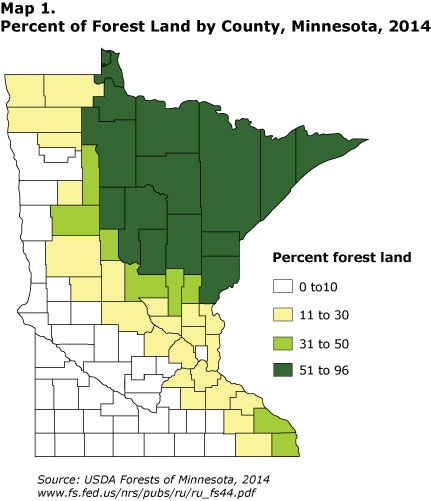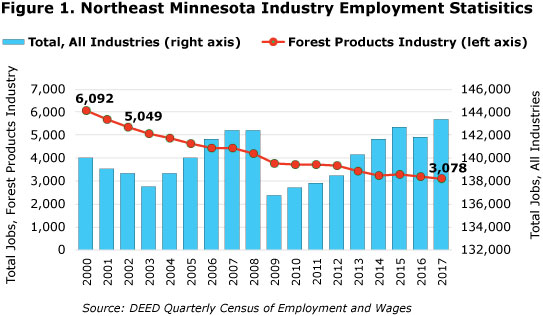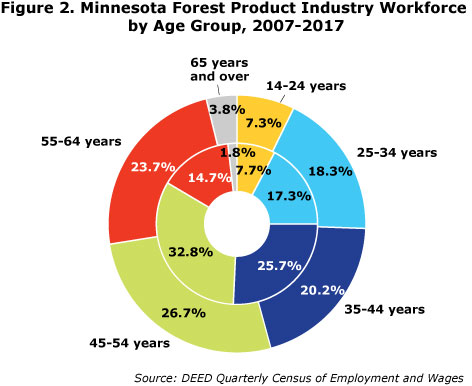by Cameron Macht
January 2019
It is not surprising that almost half of the state's remaining employment in Forestry and Logging is located in the 7-county Northeast Minnesota region (see Map 1), home to most of the state's forest land. The Forestry and Logging sector is a vital part of the Forest Product Industry which also includes establishments and employment in two other NAICS codes: 321-Wood Product Manufacturing and 322-Paper Manufacturing.

Despite long-term declines, these three sectors still combined for an average of 139 business establishments and 3,078 jobs in 2017 in Northeast Minnesota, accounting for 2.1 percent of total employment in the region. According to data from DEED's Quarterly Census of Employment and Wages program, total payroll in the Forest Product Industry neared $213 million in the region in 2017, with an average annual wage of $69,120. That was over $25,000 higher than the average wage across all industries in the region, but varied greatly by specialty. Paper Manufacturing had the highest annual wages, while Forest Nurseries and Gathering of Forest Products was among the lowest (see Table 1).
| Table 1. Northeast Minnesota Forest Products Industry Employment Statistics, 2017 | ||||||
|---|---|---|---|---|---|---|
| NAICS Code | NAICS Industry Title | Number of Firms 2017 | Number of Jobs 2017 | Location Quotient | Industry Payroll 2017 | Average Annual Wages 2017 |
| 0 | Total, All Industries | 8,644 | 143,337 | 1.0 | $6,189,287,735 | $43,160 |
| 113 | Forestry and Logging | 94 | 488 | 9.7 | $21,144,172 | $42,640 |
| 1131 | Timber Tract Operations | 4* | 8* | 11.4 | $123,178* | $61,568 |
| 1132 | Forest Nurseries and Gathering of Forest Products | 4* | 40* | 5.1 | $944,246* | $31,737 |
| 1133 | Logging | 86 | 442 | 10.6 | $19,277,355 | $42,744 |
| 1153 | Support Activities for Forestry | 7* | 8* | 1.3 | $81,822* | $40,924 |
| 321 | Wood Product Manufacturing | 35 | 637 | 1.1 | $31,647,403 | $49,660 |
| 3211 | Sawmills and Wood Preservation | 12* | 116* | 4.7 | $3,633,681* | $41,756 |
| 3212 | Veneer, Plywood, and Engineered Wood Products | 5* | 200* | 2.5 | $8,709,631* | $57,298 |
| 3219 | Other Wood Product Manufacturing | 18 | 322 | 0.7 | $14,584,988 | $45,344 |
| 322 | Paper Manufacturing | 10 | 1,953 | 4.2 | $159,960,491 | $81,900 |
| 3221 | Pulp, Paper, and Paperboard Mills | 7 | 1,913 | 15.2 | $158,805,603 | $82,992 |
| 3222 | Converted Paper Product Manufacturing | 3 | 39 | 0.1 | $1,154,888 | $29,640 |
| * only quarterly data were available, not an annual average
Source: DEED Quarterly Census of Employment and Wages (QCEW) program |
||||||
As detailed and predicted in the article "Falling Timber - Forest Products in Decline" written by former Northeast Minnesota regional analyst Scott Moore and Rachel Vilsack (nee Hillman)1, the Forest Product Industry has endured recessionary shockwaves and employment cutbacks as well as productivity growth and advances in sustainability. Many of these forces have greatly impacted the industry, remolding it into a very different shape. Since the article was published in 2003, employment in the Forest Products Industry has declined by 39 percent in Northeast Minnesota, and it's down 49.5 percent since 2000 (see Figure 1).

Paper Manufacturing is the largest sector of the Forest Product Industry in the region, with 1,953 jobs at 10 firms. Wages reached $83,000 per year at the region's huge pulp, paper, and paperboard mills, which averaged close to 275 employees per site. However, paper manufacturing employment also dropped nearly 50 percent since 2000, a loss of more than 1,700 jobs.
Likewise, Wood Product Manufacturing employers cut 66 percent of their payroll since 2000, making it the second fastest declining sector overall in the region so far this century. Interestingly, the only sector that declined faster was Support Activities for Forestry. The primary subsectors include Sawmills and Wood Preservation, Other Wood Product Manufacturing, and Veneer, Plywood, and Engineered Wood Product Manufacturing. The latter subsector sliced 75 percent of the jobs it had in 2000, a loss of nearly 600 jobs.
The smallest but perhaps most recognizable sector was Forestry and Logging, which had just under 500 jobs at 94 establishments in 2017. Logging is the largest subsector with 442 jobs at 86 firms, but was made up primarily of small businesses, with an average of just 5 employees per site. Unlike the other sectors, employment in Forestry and Logging has been relatively stable over time, declining less than 6 percent from 2000 to 2017 and even experiencing hiring growth in the past five years (see Table 2).
| Table 2. Northeast Minnesota Forest Products Industry Trends, 2007-2017 | |||||||
|---|---|---|---|---|---|---|---|
| NAICS Industry Title | Number of Jobs, 2017 | 1-Year Trend 2016-2017 | 5-Year Trend 2012-2017 | 10-Year Trend 2007-2017 | |||
| Numeric Change | Percent Change | Numeric Change | Percent Change | Numeric Change | Percent Change | ||
| Total, All Industries | 143,337 | 1,464 | 1.0% | 4,835 | 3.5% | 912 | 0.6% |
| Forestry and Logging | 488 | -15 | -3.0% | 41 | 9.2% | 5 | 1.0% |
| Timber Tract Operations | 8* | 1 | 14.3% | ND | ND | ND | ND |
| Forest Nurseries and Gathering of Forest Products | 40* | -6 | -13.0% | ND | ND | ND | ND |
| Logging | 442 | -10 | -2.2% | 34 | 8.3% | 14 | 3.3% |
| Support Activities for Forestry | 8* | -1 | -11.1% | -11 | -57.9% | ND | ND |
| Wood Product Manufacturing | 637 | -76 | -10.7% | -196 | -23.5% | -783 | -55.1% |
| Sawmills and Wood Preservation | 116* | 0 | 0.0% | -32 | -21.6% | -101 | -46.5% |
| Veneer, Plywood, and Engineered Wood Product | 200* | -13 | -6.1% | -127 | -38.8% | -490 | -71.0% |
| Other Wood Product Manufacturing | 322 | -65 | -16.8% | -33 | -9.3% | -190 | -37.1% |
| Paper Manufacturing | 1,953 | -48 | -2.4% | -431 | -18.1% | -581 | -22.9% |
| Pulp, Paper, and Paperboard Mills | 1,913 | -46 | -2.3% | -403 | -17.4% | -515 | -21.2% |
| Converted Paper Product Manufacturing | 39 | -2 | -4.9% | -28 | -41.8% | -67 | -63.2% |
| *only quarterly data were available, not an annual average
Source: DEED Quarterly Census of Employment and Wages (QCEW) program |
|||||||
Demographic data from the Quarterly Workforce Indicators program show that the Forest Product Industry labor force is relatively non-diverse, with males accounting for 78 percent of jobholders, and 94 percent reporting white alone as their race. Those percentages have remained virtually unchanged since 2007, with both shifting less than 1.6 percent despite much more rapid changes in the racial and gender composition of the overall labor force during the last decade.
However, the Forest Product Industry has seen significant changes in the age composition of the workforce over the past 10 years. The percentage of workers aged 55 to 64 years increased more than 60 percent from 2007 to 2017, and the concentration of workers aged 65 years and over more than doubled, from 1.8 percent in 2007 to 3.8 percent in 2017 (see Figure 2).

In contrast, the percentage of workers under 35 years of age stayed mostly the same, accounting for about one-fourth of the total workforce in both years. Jobholders in the 35 to 54 year old age group were affected the most, dropping from 58.5 percent of the workforce in 2007 to 46.9 percent by 2017, a shift impacted both by the aging of the workforce and on-going job cuts in the industry.
The Forest Products Industry is expected to continue cutting jobs in Northeast Minnesota in the near future. According to new regional employment projections, Wood Product Manufacturing may decline another 45 percent over the next decade, followed by an 18 percent reduction in Paper Manufacturing, although that would actually account for a larger number of jobs lost. Forestry and Logging is projected to fall just 5.8 percent.
Even if the industry continues slicing jobs, there will still be openings caused by retirements and turnover. With data showing there is less than one jobseeker for every job vacancy in the past year, there is intense competition for workers in Northeast Minnesota – especially for common occupations like heavy and tractor-trailer truck drivers, maintenance and repair workers, mobile heavy equipment mechanics, and laborers and freight movers, which are in high demand in other industries as well.
Likewise, office occupations like secretaries and administrative assistants, bookkeeping and accounting clerks, office clerks, sales representatives, and general and operations managers are also in high demand in industries across the region. Twenty of the top 25 jobs in the forest products industry can be secured with a high school diploma or equivalent and some level of the on-the-job training, while just three require vocational training and two require a bachelor's degree (see Table 3).
| Table 3. Top 25 Occupations in Demand in the Forest Products Industry in Northeast Minnesota, 2018 | ||||
|---|---|---|---|---|
| Northeast Minnesota, 2018 | Estimated Regional Employment | Median Hourly Wage | Current Demand Indicator | Typical Educational Requirement |
| Office clerks, general | 3,130 | $15.72 | ★★★★★ | High school or equivalent |
| General and operations managers | 2,070 | $36.59 | N/A | Bachelor's degree |
| Heavy and tractor-trailer truck drivers | 2,050 | $20.46 | ★★★★★ | High school or equivalent |
| Maintenance and repair workers, general | 1,920 | $18.17 | ★★★★★ | High school or equivalent |
| Bookkeeping, accounting, and auditing clerks | 1,680 | $17.24 | ★★★★★ | High school or equivalent |
| Secretaries and administrative assistants | 1,620 | $17.70 | ★★★★★ | High school or equivalent |
| Laborers and freight, stock, and material movers, hand | 1,290 | $14.73 | ★★★★★ | Less than high school |
| Sales representatives, wholesale and manufacturing | 860 | $26.02 | ★★★★★ | High school or equivalent |
| Team and all other assemblers | 670 | $13.25 | N/A | High school or equivalent |
| Helpers--production workers | 580 | $25.57 | ★★☆☆☆ | Less than high school |
| Industrial machinery mechanics | 570 | $28.22 | ★★★★★ | Postsecondary award |
| Mobile heavy equipment mechanics, except engines | 520 | $25.25 | ★★★★☆ | Postsecondary award |
| First-line supervisors of production workers | 500 | $29.26 | ★★★★★ | High school or equivalent |
| Paper goods machine setters, operators, and tenders | 370 | $31.09 | ★☆☆☆☆ | High school or equivalent |
| Inspectors, testers, sorters, samplers, and weighers | 330 | $16.79 | ★★★★★ | High school or equivalent |
| Industrial truck and tractor operators | 270 | $19.40 | ★★★★☆ | Less than high school |
| Logging equipment operators | 260 | $20.17 | ★☆☆☆☆ | High school or equivalent |
| Foresters | 140 | $30.10 | ★★★★☆ | Bachelor's degree |
| Woodworking machine setters, operators, and tenders | 140 | $14.57 | ★★★★☆ | High school or equivalent |
| Sawing machine setters, operators, and tenders, wood | 90 | $13.93 | ★☆☆☆☆ | High school or equivalent |
| Cabinetmakers and bench carpenters | 50 | $17.04 | ★★★★☆ | High school or equivalent |
| Machine feeders and offbearers | 50 | $17.70 | ★★★★☆ | Less than high school |
| First-line supervisors of farming and forestry workers | N/A | $28.28* | ★☆☆☆☆ | High school or equivalent |
| Fallers | N/A | $24.58* | N/A | High school or equivalent |
| Forest and conservation workers | N/A | $21.04* | ★★★★☆ | Postsecondary award |
| * State wage data was used because no regional wage data was available
Source: Bureau of Labor Statistics Industry-Occupation Matrix, DEED Occupations in Demand |
||||
According to DEED's Graduate Employment Outcomes tool, 58 graduated from forestry programs at colleges in Minnesota during the school year 2013 - 2014, including 22 Bachelor's degrees, 18 Associate degrees, and 18 certificates. Interestingly, median wages were higher for graduates who earned certificates than for workers with Bachelor's degrees, at least in the short term. In addition there were just 28 graduates from woodworking programs at colleges in Minnesota, and zero from paper-specific programs. There were hundreds more graduates from programs in agriculture, biology and biochemistry, natural resources and conservation, precision production, and mechanic and repair technologies, which could potentially relate to forest products in some form.
These new graduates and other jobseekers will be important in filling the workforce pipeline in the Forest Product Industry as older workers continue to reach retirement age. In the face of tight labor markets, forest product employers will need to tap into new labor pools in order to attract the talent they require to succeed in the future.